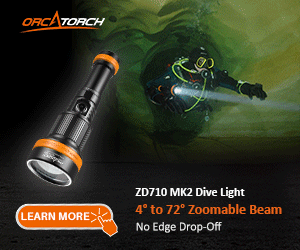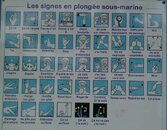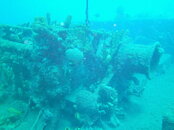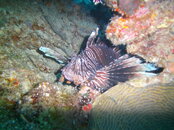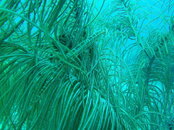elgringoperdido
Registered
Guadeloupe report (4 July – 17 July 2018)
This is my first Scubaboard post. Over the past decade or more, I have consulted this helpful forum many times to find information regarding diving and surface activities at various locations but I have been reluctant to create an account and post. Nevertheless, I have noted a dearth of information regarding Guadeloupe and I want to share my experiences with those interested. This compendium was made from notes I took while on vacation, and is likely to be a long post.
Clarification: This post regards Guadeloupe, an archipelago of at least five islands in the lesser Antilles, and an overseas department of France. Note the unusual (French) spelling of Guadeloupe. This is not a report about Isla Guadalupe, a Mexican island in the pacific. I mention this because I have found that any search for “Guadeloupe” on Scubaboard turns up multiple hits with this (mis)spelling of the Mexican island, which properly has the more common Spanish spelling of Guadalupe (used also for place names in Spain, Texas, Mexico, California, etc.) Note that the pronunciation is different as well.
Hassle factor: After several months of searching itineraries, I managed to finally find a reasonably-priced round-trip itinerary to Pointe-à-Pitre from Newark without unreasonably long flight times on expedia.com. ($440 per person for myself, my wife, and my son)
The plan: 8AM flight from Newark to Atlanta, a bit more than one hour layover in Atlanta, then fly to PTP. Arrive at PTP at 3:50 PM.
The reality: We awoke at 3:30 to have breakfast and make the two-hour drive to Newark, parked the car, arrived at the Delta check-in at 6AM only to be told that the flight would be delayed by 2 hours. Unfortunately this meant that we would miss our connecting flight to Guadeloupe and there were no other flights to Guadeloupe that day. After much frantic searching, the Delta agent said that our best bet would be a flight to Miami (from JFK!) at 3pm, an overnight in Miami, then a 9:05 AM flight to PTP. She apologized profusely, provided a voucher for the nearly one-hour cab ride from Newark to JFK, a 50-dollar voucher for us to have breakfast at JFK, and Delta paid for our hotel room in Miami that night. We accepted the offer, made long cab ride to JFK, ate breakfast, and cooled our heels for several hours at JFK. The 3pm flight was on time, luggage managed to get on the correct flight, and our hotel room wasn’t bad (Double Tree). In the morning, we took the 6:30 shuttle from Double Tree Miami International, and flew to PTP on an Air France flight, which stopped at Port-au-Prince, Haiti, for about an hour while we waited on board.
Silver lining: the Air France food was much better than Delta, and we were given two small meals, one between MIA and Haiti, and one between Haiti and PTP. The plane was also clean and comfortable compared to Delta and there was a nice selection of movies. I watched “The Darkest Hour.” You’ll enjoy this film if you’re into military history.
I relate that story mostly to impress upon you that getting to PTP from the USA can be a major hassle. Most flights are very expensive and require 20+ hours transit. I managed to find one, reasonably priced, that should only have been eight hours, but we were at the mercy of factors beyond our control, and ended up having a 29-hour transit time anyway. A cursory scan of TripAdvisor will confirm that many others have had similar experiences.
Arrival in Guadeloupe: I was pleasantly impressed by the PTP airport—very clean and in good shape. Also I was surprised by the lack of bureaucracy upon entering Guadeloupe (especially given the impressive number of complaints I’ve heard from Frenchmen about their government’s burdensome bureaucracy.) No forms to fill out on the plane. No forms upon landing. French and foreigners were all in the same fast-moving line. We just showed the woman at immigration our passports, she stamped them, and we moved on. Luggage arrived immediately. No hassle at Customs either. No red light/green light. No questions. Everyone just passed through while the customs officers smiled at us and waved us onward.
Outside, we immediately found the car rental place. Another pleasant surprise was that they (at least the Budget people) spoke English rather well. I was prepared to pick up an airport phone, tell the person answering it that we had reservations and were awaiting the shuttle, in French, but none of that was necessary. They gave us a tiny white Opel Z five-speed (cheapest available car) noted the scratches on the exterior, and sent us on our way with an admonition to return the car full of gas.
The drive to St. François: Highways were in good condition, smaller roads were treacherous. Major roads signed well. Secondary roads not so much. We had to double back twice, but overall it wasn’t bad. Driving was interesting, but not as stressful as driving in, say, NYC or Washington DC.
We arrived at our Condo in St. François where we stayed the first week (well, six days because of the flight delay). Our condo owner spoke no English, but we expected that. She was very friendly, showed us the place, gave us the wifi password, explained about the garbage, keys, etc., and I was able to communicate well enough with her in my schoolboy French. (If you do not speak any French your experiences in Guadeloupe will be somewhat limited.)
Diving in Grand Terre: In Grand Terre, I dived with Noa Plongée: one two-tank package. (I would also dive on Basse Terre; more about that later.) We met at their shop (a block from the pier) at 7:30 am and, as the battery in my Mares Puck had just died, they lent me a dive computer—off the record, no charge. I was buddied with Jean-Louis, a 63-year-old from Lorraine who spoke no English. He is a CMAS*** diver, and since I have 13 certifications and have been down to over 100 meters they considered me to be roughly 3-star slso and said that Jean-Louis and I would be “autonomous” and make our own plan. The others on the boat, a French couple and a Guadeloupean, were less experienced and were not considered to be “autonomous” and they stayed with Alexis, the captain/instructor/mate. I call him all that because he was the only employee on the boat. The boat was nice (covered, shade), and looked like it could accommodate about 12 divers. It had a large platform at the stern with sturdy ladder. But there was no crew. The sea was choppy that day. Really choppy! 2.5 meter waves, according to Alexis. The boat was tossed quite a bit and Jean-Louis lost his breakfast over the side. We got to a site called Le Lac, which was maybe 17 meters max depth, very flat, with some coral formations and a strong circular current. Alexis gave a briefing in French and kept looking at me (“vous comprenez?”) Yes, I understand (mostly). Units were bars, meters, and degrees celcius. He wanted Jean-Louis and me to inform each other when we got to 100 bar (a symbol that looked like a US football “touchdown” symbol) and again at 50 bar (the right hand made into a loose fist and placed right of the forehead). They do not seem to have familiarity with the TDI one-handed numeral system for indicating pressure, but some have an awareness that English people, Americans, Canadians, etc., use the index finger to begin counting, unlike the French and Germans. I used 4 kilograms of lead. Two kilos each in my BCD pockets. They loaned me a DIN-to-A clamp adapter and a hex wrench to install it. It worked out well.
Visibility was not as high as Cozumel or Bonaire, but better than the North Atlantic. The waves were very big. (Think: NJ wreck diving in October.) St. François is near the westernmost point of the western edge of the butterfly, where the Atlantic meets the Caribbean. The water was warm enough (28°C) so I only wore a lycra skin and heavy booties. I also used my big scubapro tech diving fins. Otherwise, I used my recreational gear (Cressi Travel-light BCD, Oceanic CDX5 first stage with oceanic primary and alternate 2nd stages, Cressi Big Eyes low-volume mask, and Sea-Life camera).
The second dive was similar. 16 meters max depth, 55 minutes. Vis was okay (15 meters maybe). Some sea life, but not much. Large barracuda, peacock flounder, wrasses, puffers, groupers, lobsters. One very special moment was when Jean-Louis found a juvenile spotted drum. Tiny black-and-white ribbon among the reef. I usually don’t find such small things on my own, so I am glad he pointed it out.
Bear in mind that the boat was completely unmanned during our dives. Alexis explained that this is normal in Guadeloupe. The captain is also the divermaster, mate, etc. We all rolled in backward from the side, then he joined us. We went down, Jean-Louis and I together, and the other four together. We met again about 45 minutes later on the bottom near a fixed anchorage for a tie-off buoy, and worked our way up to a 5-meter safety stop near the boat. We were given very specific instructions about climbing aboard, which was good because when we looked up from the safety stop we could see the latter going up and down out of the water, testament to those two-meter waves. Do not remove fins. Grab the ladder firmly on the third rungs during a trough in the wave. Get the feet quickly on the bottom rung. Keep all the weight on the ladder to keep it from bouncing and bruising the legs. With fins on, step carefully one rung at a time, keeping full weight on the ladder. Get to the top and keep holding on to the rail. Make your way quickly to the bench and then remove fins. (I suspect that he has had to go down to retrieve fins more than once, thus the admonition about keeping fins on.)
This is my first Scubaboard post. Over the past decade or more, I have consulted this helpful forum many times to find information regarding diving and surface activities at various locations but I have been reluctant to create an account and post. Nevertheless, I have noted a dearth of information regarding Guadeloupe and I want to share my experiences with those interested. This compendium was made from notes I took while on vacation, and is likely to be a long post.
Clarification: This post regards Guadeloupe, an archipelago of at least five islands in the lesser Antilles, and an overseas department of France. Note the unusual (French) spelling of Guadeloupe. This is not a report about Isla Guadalupe, a Mexican island in the pacific. I mention this because I have found that any search for “Guadeloupe” on Scubaboard turns up multiple hits with this (mis)spelling of the Mexican island, which properly has the more common Spanish spelling of Guadalupe (used also for place names in Spain, Texas, Mexico, California, etc.) Note that the pronunciation is different as well.
Hassle factor: After several months of searching itineraries, I managed to finally find a reasonably-priced round-trip itinerary to Pointe-à-Pitre from Newark without unreasonably long flight times on expedia.com. ($440 per person for myself, my wife, and my son)
The plan: 8AM flight from Newark to Atlanta, a bit more than one hour layover in Atlanta, then fly to PTP. Arrive at PTP at 3:50 PM.
The reality: We awoke at 3:30 to have breakfast and make the two-hour drive to Newark, parked the car, arrived at the Delta check-in at 6AM only to be told that the flight would be delayed by 2 hours. Unfortunately this meant that we would miss our connecting flight to Guadeloupe and there were no other flights to Guadeloupe that day. After much frantic searching, the Delta agent said that our best bet would be a flight to Miami (from JFK!) at 3pm, an overnight in Miami, then a 9:05 AM flight to PTP. She apologized profusely, provided a voucher for the nearly one-hour cab ride from Newark to JFK, a 50-dollar voucher for us to have breakfast at JFK, and Delta paid for our hotel room in Miami that night. We accepted the offer, made long cab ride to JFK, ate breakfast, and cooled our heels for several hours at JFK. The 3pm flight was on time, luggage managed to get on the correct flight, and our hotel room wasn’t bad (Double Tree). In the morning, we took the 6:30 shuttle from Double Tree Miami International, and flew to PTP on an Air France flight, which stopped at Port-au-Prince, Haiti, for about an hour while we waited on board.
Silver lining: the Air France food was much better than Delta, and we were given two small meals, one between MIA and Haiti, and one between Haiti and PTP. The plane was also clean and comfortable compared to Delta and there was a nice selection of movies. I watched “The Darkest Hour.” You’ll enjoy this film if you’re into military history.
I relate that story mostly to impress upon you that getting to PTP from the USA can be a major hassle. Most flights are very expensive and require 20+ hours transit. I managed to find one, reasonably priced, that should only have been eight hours, but we were at the mercy of factors beyond our control, and ended up having a 29-hour transit time anyway. A cursory scan of TripAdvisor will confirm that many others have had similar experiences.
Arrival in Guadeloupe: I was pleasantly impressed by the PTP airport—very clean and in good shape. Also I was surprised by the lack of bureaucracy upon entering Guadeloupe (especially given the impressive number of complaints I’ve heard from Frenchmen about their government’s burdensome bureaucracy.) No forms to fill out on the plane. No forms upon landing. French and foreigners were all in the same fast-moving line. We just showed the woman at immigration our passports, she stamped them, and we moved on. Luggage arrived immediately. No hassle at Customs either. No red light/green light. No questions. Everyone just passed through while the customs officers smiled at us and waved us onward.
Outside, we immediately found the car rental place. Another pleasant surprise was that they (at least the Budget people) spoke English rather well. I was prepared to pick up an airport phone, tell the person answering it that we had reservations and were awaiting the shuttle, in French, but none of that was necessary. They gave us a tiny white Opel Z five-speed (cheapest available car) noted the scratches on the exterior, and sent us on our way with an admonition to return the car full of gas.
The drive to St. François: Highways were in good condition, smaller roads were treacherous. Major roads signed well. Secondary roads not so much. We had to double back twice, but overall it wasn’t bad. Driving was interesting, but not as stressful as driving in, say, NYC or Washington DC.
We arrived at our Condo in St. François where we stayed the first week (well, six days because of the flight delay). Our condo owner spoke no English, but we expected that. She was very friendly, showed us the place, gave us the wifi password, explained about the garbage, keys, etc., and I was able to communicate well enough with her in my schoolboy French. (If you do not speak any French your experiences in Guadeloupe will be somewhat limited.)
Diving in Grand Terre: In Grand Terre, I dived with Noa Plongée: one two-tank package. (I would also dive on Basse Terre; more about that later.) We met at their shop (a block from the pier) at 7:30 am and, as the battery in my Mares Puck had just died, they lent me a dive computer—off the record, no charge. I was buddied with Jean-Louis, a 63-year-old from Lorraine who spoke no English. He is a CMAS*** diver, and since I have 13 certifications and have been down to over 100 meters they considered me to be roughly 3-star slso and said that Jean-Louis and I would be “autonomous” and make our own plan. The others on the boat, a French couple and a Guadeloupean, were less experienced and were not considered to be “autonomous” and they stayed with Alexis, the captain/instructor/mate. I call him all that because he was the only employee on the boat. The boat was nice (covered, shade), and looked like it could accommodate about 12 divers. It had a large platform at the stern with sturdy ladder. But there was no crew. The sea was choppy that day. Really choppy! 2.5 meter waves, according to Alexis. The boat was tossed quite a bit and Jean-Louis lost his breakfast over the side. We got to a site called Le Lac, which was maybe 17 meters max depth, very flat, with some coral formations and a strong circular current. Alexis gave a briefing in French and kept looking at me (“vous comprenez?”) Yes, I understand (mostly). Units were bars, meters, and degrees celcius. He wanted Jean-Louis and me to inform each other when we got to 100 bar (a symbol that looked like a US football “touchdown” symbol) and again at 50 bar (the right hand made into a loose fist and placed right of the forehead). They do not seem to have familiarity with the TDI one-handed numeral system for indicating pressure, but some have an awareness that English people, Americans, Canadians, etc., use the index finger to begin counting, unlike the French and Germans. I used 4 kilograms of lead. Two kilos each in my BCD pockets. They loaned me a DIN-to-A clamp adapter and a hex wrench to install it. It worked out well.
Visibility was not as high as Cozumel or Bonaire, but better than the North Atlantic. The waves were very big. (Think: NJ wreck diving in October.) St. François is near the westernmost point of the western edge of the butterfly, where the Atlantic meets the Caribbean. The water was warm enough (28°C) so I only wore a lycra skin and heavy booties. I also used my big scubapro tech diving fins. Otherwise, I used my recreational gear (Cressi Travel-light BCD, Oceanic CDX5 first stage with oceanic primary and alternate 2nd stages, Cressi Big Eyes low-volume mask, and Sea-Life camera).
The second dive was similar. 16 meters max depth, 55 minutes. Vis was okay (15 meters maybe). Some sea life, but not much. Large barracuda, peacock flounder, wrasses, puffers, groupers, lobsters. One very special moment was when Jean-Louis found a juvenile spotted drum. Tiny black-and-white ribbon among the reef. I usually don’t find such small things on my own, so I am glad he pointed it out.
Bear in mind that the boat was completely unmanned during our dives. Alexis explained that this is normal in Guadeloupe. The captain is also the divermaster, mate, etc. We all rolled in backward from the side, then he joined us. We went down, Jean-Louis and I together, and the other four together. We met again about 45 minutes later on the bottom near a fixed anchorage for a tie-off buoy, and worked our way up to a 5-meter safety stop near the boat. We were given very specific instructions about climbing aboard, which was good because when we looked up from the safety stop we could see the latter going up and down out of the water, testament to those two-meter waves. Do not remove fins. Grab the ladder firmly on the third rungs during a trough in the wave. Get the feet quickly on the bottom rung. Keep all the weight on the ladder to keep it from bouncing and bruising the legs. With fins on, step carefully one rung at a time, keeping full weight on the ladder. Get to the top and keep holding on to the rail. Make your way quickly to the bench and then remove fins. (I suspect that he has had to go down to retrieve fins more than once, thus the admonition about keeping fins on.)
Last edited:


